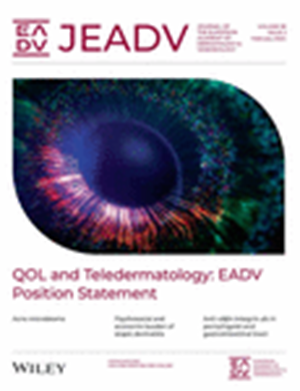斑秃患者的毛发再生和白癜风患者的色素沉着:共性与差异
IF 8.4
2区 医学
Q1 DERMATOLOGY
Journal of the European Academy of Dermatology and Venereology
Pub Date : 2024-09-11
DOI:10.1111/jdv.20311
引用次数: 0
摘要
斑秃(AA)和白癜风都有共同的发病机制,涉及激活细胞毒性 CD8+ T 淋巴细胞的干扰素-γ(IFN-γ)和白细胞介素-15(IL-15)信号通路。这些共同的机制可以解释为什么这两种疾病都对目前可用的治疗方法(如局部/全身皮质类固醇)和新出现的治疗模式有反应。与白癜风皮损中色素再沉着的速度相比,AA 皮损中色素末端毛囊的再生速度似乎很快,这与抑制 Janus 激酶(JAKs)和其他激酶的治疗方法有关。我们总结了AA和白癜风的共同点和不同点,重点是治疗方法,然后是与毛发隆起(HBg)中的毛囊干细胞(HFSC)以及HBg和毛胚芽(HGm)中的黑素细胞干细胞(McSC)相关的最新发现。然后,我们将讨论 HFSC 和 HGm-McSC 如何参与生长期的启动,以及 AA 病变恢复期色素末端毛发的再生与免疫学的关系。我们还讨论了 HBg-间充质干细胞如何促进完全树突状成熟黑色素细胞迁移到角质层表皮间,以及如何促进恢复期白癜风皮损中黑色素的平均分布。最后,我们提出了四个假设,从干细胞生物学的角度来解释成熟黑色素细胞在脱色白癜风皮损中黑色素分布延迟的原因,与AA快速毛发恢复相比:(1)McSC的数量少于HFSC。(2) 麦粒干细胞需要长途跋涉,而高频干细胞靠近毛发再生触发点。(3) 角质形成细胞接受黑色素的支架保存不良,而毛发再生的支架保存良好。(4)针对 JAKs 和其他激酶的抑制剂对白癜风患者黑色素细胞增殖和分化的直接影响小于对 AA 型毛发再生的直接影响。我们的综述概述了各种治疗方法,并在 AA 和白癜风治疗的科学进步与临床实践之间架起了一座桥梁。本文章由计算机程序翻译,如有差异,请以英文原文为准。
Hair regrowth in alopecia areata and re‐pigmentation in vitiligo in response to treatment: Commonalities and differences
Both alopecia areata (AA) and vitiligo share common pathogenesis involving, interferon‐γ (IFN‐γ) and interleukin‐15 (IL‐15) signalling pathways that activate cytotoxic CD8+ T lymphocytes. These shared mechanisms may explain why both diseases respond to currently available treatments (e.g. topical/systemic corticosteroid) and emerging treatment modalities. As compared with the speed of re‐pigmentation in vitiligo lesions, the regeneration of pigmented terminal hair follicles in AA lesions appears fast in response to treatments targeting the inhibition of the Janus kinases (JAKs) and other kinases. We summarize the commonalities and differences between AA and vitiligo focusing on the treatment modalities, followed by recent findings associated with hair follicle stem cells (HFSC) in hair bulge (HBg) and melanocyte stem cells (McSC) in HBg and hair germ (HGm). We then discuss how HFSC and HGm‐McSC are involved in the initiation of anagen phase, followed by pigmented terminal hair regrowth in the recovering AA lesions in association with immunology. We also discuss how HBg‐McSC contribute to the migration of fully dendritic mature melanocytes into interfollicular epidermis and the equal distribution of melanin in recovering vitiligo lesions. Finally, we present four hypotheses to elucidate the delayed distribution of melanin by mature melanocytes in depigmented vitiligo lesions from the aspects of stem cell biology, as compared with quick hair recovery in AA: (1) McSC are less abundant than HFSC. (2) McSC require a long travel, whereas HFSC reside close to hair regeneration trigger point. (3) Keratinocyte scaffold to accept melanin is not well preserved, whereas scaffold for hair regrowth is well preserved. (4) Inhibitors targeting JAKs and other kinases have less direct effects on melanocyte proliferation and differentiation in vitiligo than hair regrowth in AA. Our review provides an overview of treatment modalities and bridges the gap between scientific advancement and clinical practice in AA and vitiligo management.
求助全文
通过发布文献求助,成功后即可免费获取论文全文。
去求助
来源期刊
CiteScore
10.70
自引率
8.70%
发文量
874
审稿时长
3-6 weeks
期刊介绍:
The Journal of the European Academy of Dermatology and Venereology (JEADV) is a publication that focuses on dermatology and venereology. It covers various topics within these fields, including both clinical and basic science subjects. The journal publishes articles in different formats, such as editorials, review articles, practice articles, original papers, short reports, letters to the editor, features, and announcements from the European Academy of Dermatology and Venereology (EADV).
The journal covers a wide range of keywords, including allergy, cancer, clinical medicine, cytokines, dermatology, drug reactions, hair disease, laser therapy, nail disease, oncology, skin cancer, skin disease, therapeutics, tumors, virus infections, and venereology.
The JEADV is indexed and abstracted by various databases and resources, including Abstracts on Hygiene & Communicable Diseases, Academic Search, AgBiotech News & Information, Botanical Pesticides, CAB Abstracts®, Embase, Global Health, InfoTrac, Ingenta Select, MEDLINE/PubMed, Science Citation Index Expanded, and others.

 求助内容:
求助内容: 应助结果提醒方式:
应助结果提醒方式:


